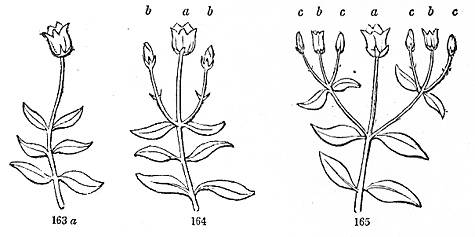

From Gray's Lessons in Botany and Vegetable Physiology:1
A Cyme. This is commonly a flat-topped or convex flower-cluster, like a corymb, only the blossoms are from terminal buds. Fig. 164 illustrates the simplest cyme in a plant with opposite leaves, namely, with three flowers. The middle flower, a, terminates the stem; the two others, b b, terminate short branches, one from the axil of each of the upermost leaves; and being later than the middle one, the flowering proceeds from the centre outwards, or os centrifugal - just the opposite of the indeterminate mode, or that where all flowers are axillary. If flowering branches appear from the axils below, the lower ones are the later so that the order of blooming continues centrifugally or descending (which is the same thing), as in Fig. 166.
FIG 163. Diagram of an opposite-leaved plant with a single terminal flower. 164 Same, with a cyle of three flowers: a, the first flower, of the main axis; b b, those of branches. 165. Same, with flowers of the third order, c,c. 166. Same, with flowers only of the second order from all the axils; the central or uppermost opening first, and so on downwards.
1. Asa Gray. 1880. Gray's Lessons in Botany and Vegetable Physiology Vision, Blakeman, Taylor & Co., New York and Chicago, 1880.